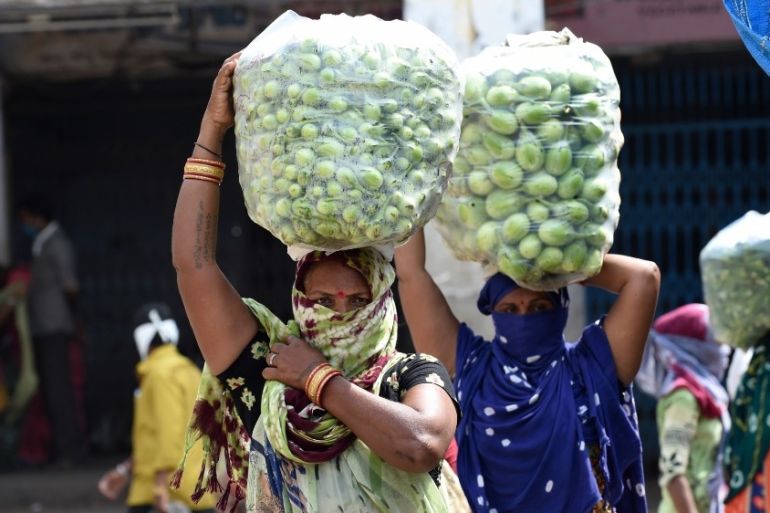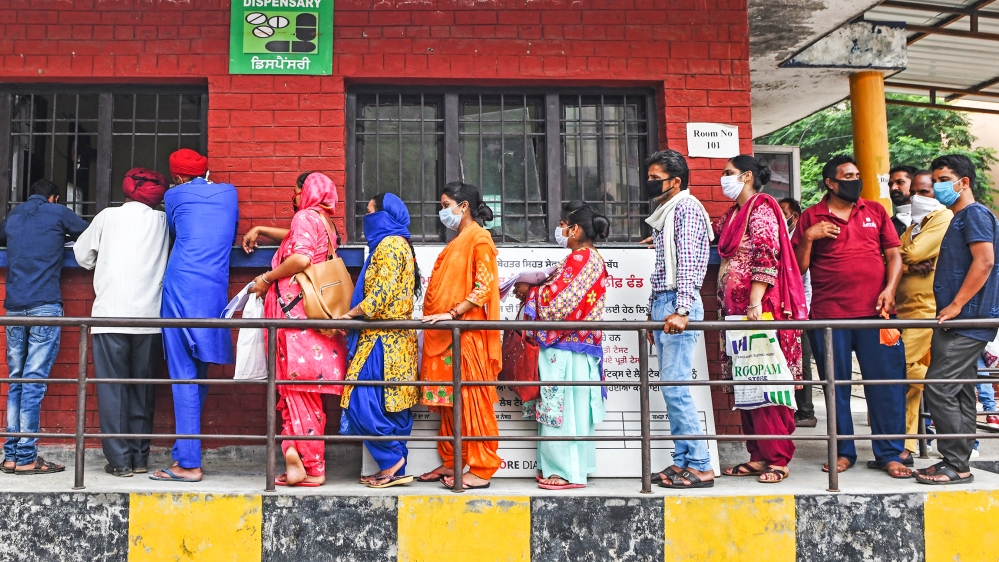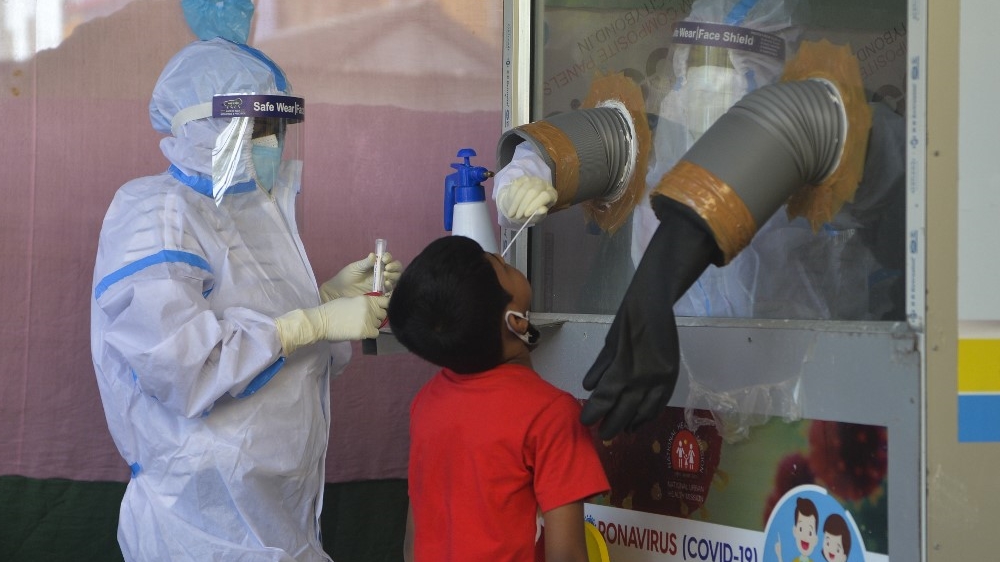What explains surge in coronavirus numbers in India?
New global record of 96,551 new cases registered – infection rate that could see India overtake the US in coming weeks.

New Delhi, India – India has added another 300,000 coronavirus infections to its caseload in the past four days, an infection rate which could see it overtake the United States to become the world’s worst-affected country within weeks.
The country registered 96,551 new cases – a fresh global record – on Friday.
Keep reading
list of 4 itemsMexico’s teachers seek relief from pandemic-era spike in school robberies
‘A bad chapter’: Tracing the origins of Ecuador’s rise in gang violence
Why is the US economy so resilient?
On Monday, India had surpassed Brazil as the country with the second-highest number of coronavirus cases in the world, with 4.2 million cases. The US has a caseload of 6.4 million infections.
More than 76,000 people in India have died due to the coronavirus, which has killed more than 909,000 people worldwide.
India’s health ministry says the surge in cases is due to an increase in daily testing that has now exceeded one million.
Despite the steep surge in new cases and deaths, India continues to ease restrictions and open up its economy to make up for losses incurred during its long and punishing lockdown period, which experts believe was rushed through and “illogical”.
The lockdown was wrong, it just destroyed our economy.
The March lockdown forced hundreds of thousands of workers to flee cities for their homes, and experts say it probably contributed to the spread of the virus in rural areas.
Moreover, they say that the government has not successfully communicated an effective and uniform message on masking, social distancing and congregation – measures that could have helped contain the spread of the outbreak.
As the infections spike in rural areas, health experts say the country’s crumbling rural health sector is not equipped to deal with the surge in cases in the world’s second-most populous nation.
The only silver lining for the government is the high recovery rate (77 percent) and the low mortality rate (1.6 percent) – points the government continues to emphasise.
Poor health infrastructure
Even in cities, patients have had to suffer due to poor hospital facilities and protocols. Mohinder Kaur, who was admitted to a government-run Guru Teg Bahadur Hospital in the capital, New Delhi, after testing COVID-19 positive, told Al Jazeera of her ordeal.
“No one would come near us or even help us. If anyone would accidentally touch us, the staff would shout at them for ruining a PPE (personal protective equipment) kit, the 75-year-old retired school teacher told Al Jazeera.
If lockdown was not enforced earlier, we would have been in an even worse position.
“In this heat, the fans were not working and the staff would not get them fixed despite several complaints. The toilets were filthy and sometimes had no water. The ward had rats, lizards, cats and even dogs roaming around. It was a living hell and we are fortunate to have survived this,” she said.
India’s capital still has better health facilities in comparison to rural areas where only 20 percent of India’s doctors and 40 percent of hospitals are located. Health experts feel that this could put millions of people at risk.

“India’s epidemic is two-part, urban followed by rural, each consisting of innumerable outbreaks – each district or city/large town with its own outbreak, the sum total is what is seen in numbers,” said Dr T Jacob John, epidemiologist and former professor at Christian Medical College, Vellore.
“In the last week of August, the epidemic reached all nooks and corners – evidenced by infection among tribal communities. That means, spatially the epidemic has peaked,” he said.
Stage four of the pandemic
John says India has entered stage four of the pandemic, which means the country is seeing widespread transmission, and that is reflected in the record number of daily infections in the past several weeks.
But the government has so far steadfastly denied community transmission, during which the source of contagion is not known. John says India witnessed community transmission (stage three) between March and July.
Mask-wearing and avoiding crowding, school closure etc has definitely flattened the curve a little bit, not as much as we could have achieved had we done lockdowns in a planned manner.
The epidemiologist said authorities must move from the idea of “control” to “mitigation”.
Preeti Kumar, vice president, public health system support at the Public Health Foundation of India (PHFI), a public-private non-profit, pointed out that India is a federal state and health is largely a state subject.
“Each state has implemented the response based on the strength of its health system and available resources,” Kumar told Al Jazeera.
“Kerala and Punjab states introduced lockdowns even before the rest of the country did. Four southern states (with stronger health systems) have also tested more and reported better.
“In contrast, the poorer northern states with weaker health systems, are only now beginning to feel the impact and are struggling with testing, tracing, treating and reporting,” she said.
According to Kumar, the Indian government provided much of the leadership in the early stage of the pandemic, and continues to support through strategic guidelines, expertise and some level of funding.
Ineffective lockdown
Prime Minister Narendra Modi’s Bharatiya Janata Party (BJP) government had introduced one of the world’s strictest lockdowns, triggering a working-class exodus from cities to rural areas and smaller towns.
The two-month lockdown led to the shuttering of factories and loss of millions of jobs, and experts say the decision, taken at four hours’ notice, was “ineffective and unscientific”.

“The lockdown was wrong, it just destroyed our economy,” said Dr Jayaprakash Muliyil, epidemiologist and chairperson of the Scientific Advisory Committee of the National Institute of Epidemiology.
Calling it a rushed move, Christian Medical College’s John said India’s lockdown had no scientific support. “National lockdown was illogical. It was necessary in different states at different times as they reached phase three,” he said.
Meanwhile, Kumar of PHFI believes that other countries like South Korea, Japan, Thailand and Taiwan did not see the rise in cases the way India has seen post-lockdown because they had invested heavily in testing, contact-tracing and quarantine.
“Lockdown was declared to help buy time to prepare the system to cope – prepare facilities, equipment, consumables, testing labs, surveillance systems and health workforce,“ Kumar said.
“These countries also had widespread use of masks, distancing, etc. These interventions together helped flatten the curve. Our scale-up in testing has taken more time, starting from a very low base. Lastly, our public measures and awareness on masking, hygiene and distancing are very low.”
In India, especially in rural areas and even semi-urban areas, poor hygiene standards and lack of social distancing measures further contributed to the spread of the virus, experts say.
“Poor sanitation is the government’s failure,” said John.
Beyond the big metros, there is little information on wearing masks. I think the communication has not been sufficiently effective and sustained to spread awareness about it.
Kumar from PHFI blamed the government for not successfully communicating an effective, uniform message on masking, distancing and congregating.
“Beyond the big metros, there is little information on wearing masks. I think the communication has not been sufficiently effective and sustained to spread awareness about it. Opening up is being perceived by people as if the epidemic is no more a threat. This incorrect perception needs to be addressed,” she added.
According to her, countries which have managed to flatten the curve have relied on the government to scale up testing, contact tracing and treatment. “Alongside, they have effective policies on active public engagement on masking and distancing,” she told Al Jazeera.
India has conducted 54 million tests so far, compared with the US which has conducted more than 90 million tests. The US population is a quarter of India’s 1.4 billion people.
Governing party spokesman defends gov’t
On flattening the curve, John said, “Mask-wearing and avoiding crowding, school closure etc has definitely flattened the curve a little bit, not as much as we could have achieved had we done lockdowns in a planned manner.”
The only silver lining for India in its fight against the pandemic is its low mortality rate. Experts say the mortality rate is also low in neighbouring countries.
“Fortunately, COVID-19 mortality is quite low in India, Pakistan, Bangladesh and Sri Lanka. Median age in these countries is below 30 and that is one reason for the low mortality. Mortality is also declining globally – my hypothesis is that the virus is becoming less virulent, a natural phenomenon in new hosts and multiple generations of virus growth,” said John.
A spokesman from the BJP defended the Modi government’s management of the pandemic.
“Those who are saying that lockdown was unscientific have wrong intentions,” Bizay Sonkar Shastri, BJP’s national spokesperson, told Al Jazeera.
“It is because of lockdown that our daily numbers are at around 90,000, otherwise they would been in lakhs [hundred of thousands]. If lockdown was not enforced earlier, we would have been in an even worse position.
“Those who are raising questions about the lockdown are anti-Modi and anti-BJP,” he said.
